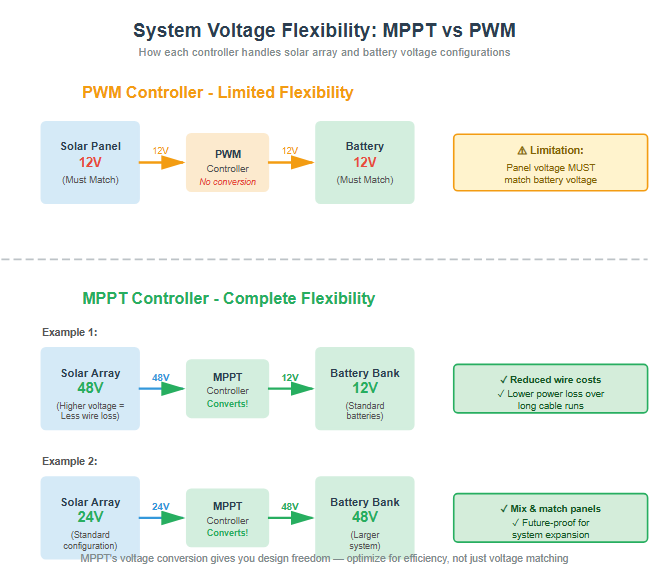
If you’re investing in a solar power system for your home or business in India, you’ve likely heard about solar panels and inverters. But there’s a third, crucial component that acts as the brain of your entire operation: the solar charge controller.
And not all controllers are created equal. Choosing the right one is the difference between just having solar power and maximizing your solar power. Today, we’re breaking down the technology that makes the biggest difference: the MPPT solar charge controller.
The Heart of the Matter: MPPT vs. PWM
Think of your solar panels as a powerful water pump, and your batteries as the storage tank. A simple PWM (Pulse Width Modulation) controller is like a basic valve—it turns the flow on and off to prevent overfilling.
An MPPT (Maximum Power Point Tracking) charge controller, however, is like a smart, variable-speed pump. It doesn’t just let power through; it actively hunts for the solar panel’s “sweet spot” (the Maximum Power Point) and transforms the excess voltage into additional charging current for your batteries.

Why This Matters in India
India’s climate is diverse—from intense summer sun to hazy winters and monsoon clouds. These fluctuating conditions constantly change the Maximum Power Point of your solar panels. A basic PWM controller gets confused and inefficient in these scenarios, wasting precious solar energy. An MPPT controller dynamically adapts, ensuring you squeeze every possible watt of electricity from the available sunlight.
6 Reasons an MPPT Controller is a Non-Negotiable for Your System
1. Significant Increase in Efficiency: MPPT controllers can be up to 30% more efficient than PWM models. This means you either get more power from the same number of panels or can achieve your power goals with fewer panels, saving on initial costs.

2. Excellent Return on Investment (ROI): While the upfront cost is higher, the increased energy harvest means your system pays for itself faster. The extra electricity you generate daily quickly offsets the initial price difference.

3. Superior Performance in Low-Light: For early mornings, late evenings, and cloudy days, MPPT technology excels at pulling energy where PWM controllers struggle. This extends your effective “solar hours” each day.

4. Flexibility in System Design: MPPT controllers allow you to use higher voltage solar arrays (e.g., 24V or 48V) with lower voltage battery banks (e.g., 12V). This reduces energy loss over long wire runs, a common issue in larger installations.

5. Reduced System Stress and Longer Life: By optimizing the charge cycle and preventing battery damage from under or overcharging, a high-quality MPPT charge controller extends the lifespan of your entire system, especially your expensive batteries.

6. Future-Proofing Your Investment: As you expand your solar capacity, a robust MPPT controller from a reputable charge controller manufacturer in India can often handle the upgrade, protecting your initial investment.
Making the Right Choice
For anyone serious about solar power in India, the choice is clear. The advanced performance and long-term savings of an MPPT controller make it the only logical choice for systems over 200 watts.
When selecting a controller, look for a trusted charge controller manufacturer in India, like us at Systellar, who designs products specifically for the unique demands of the Indian market. Don’t let a simple component become the bottleneck in your renewable energy journey.
Summary
This blog explains why an MPPT solar charge controller is essential for maximizing a solar power system’s efficiency in India. It breaks down the key differences between MPPT and older PWM technology, using simple analogies and data to show how MPPT can harvest up to 30% more energy. We list six compelling reasons, from better ROI to superior low-light performance, that make MPPT a smart, non-negotiable investment. Choosing a high-quality MPPT controller from a reputable Indian manufacturer ensures your system performs optimally for years to come.
Elaboration of the Topic in 6 Points
1. Core Technology Explained: MPPT technology is an active electronic system that constantly adjusts the electrical operating point of the solar modules to extract the maximum possible power, unlike PWM’s simple “on/off” switching.
2. The Indian Climate Advantage: The variable weather patterns in India—including peak sun, haze, and monsoon clouds—create ideal conditions for MPPT technology to demonstrate its superiority over PWM, which performs poorly outside of perfect, consistent sunlight.

3. Financial Justification (ROI): The article justifies the higher initial cost by focusing on the long-term savings. The increased daily energy yield directly translates to lower electricity bills, meaning the price premium is recovered quickly, making it a financially sound decision.
4. System Design Flexibility: A key technical benefit is the decoupling of solar array voltage from battery bank voltage. This allows for more cost-effective and efficient wiring, especially in installations where panels are located far from the batteries.
5. Battery Health and Longevity: Beyond energy harvest, a quality MPPT controller provides sophisticated, multi-stage battery charging (bulk, absorption, float). This precise charging is critical for preventing sulfation and other damage, thereby extending the life of the most expensive and perishable part of a solar system: the batteries.
6. The Manufacturer’s Role: Emphasizing the importance of choosing a reputable manufacturer based in India highlights benefits like localized support, understanding of local grid standards and weather, easier access to warranties, and products designed specifically for the Indian voltage and climate conditions.
